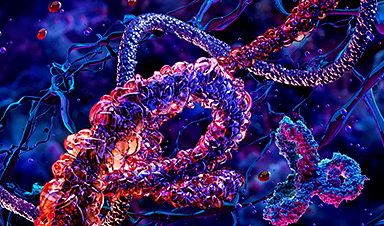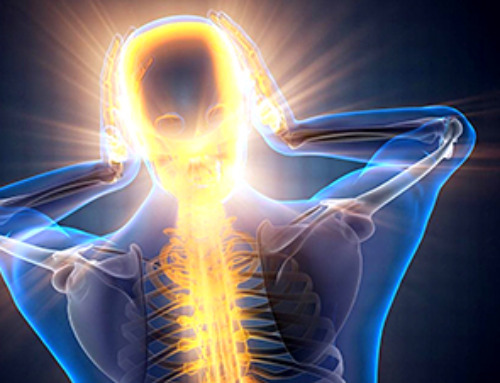Researchers used advanced microscopy to uncover important protein structures.
For the first time, two important protein structures in the human body are being visualized, thanks in part to cutting-edge technology at the University of Cincinnati’s Center for Advanced Structural Biology. This breakthrough could lead to the development of more effective therapeutics.
The research, conducted by a team of structural biologists at UC, was published in the Proceedings of the National Academy of Sciences (PNAS).
This is the first publication from the Seegar Lab at UC. Tom Seegar, PhD, Ohio Eminent Scholar and assistant professor in the Department of Molecular and Cellular Biosciences in the College of Medicine, is the corresponding author.
The study’s first authors are Joe Maciag, PhD, a research scientist in the Seegar Lab, and Conner Slone, a graduate student assistant in the same lab.
For the first time, they are visualizing the physical, atomic structure of two protein complexes, observing how they interact, how their functions change, and how this process drives inflammatory signaling.
“If you can see something, you can figure out how it works,” said Seegar. “We are figuring out what this enzyme looks like and how it’s regulated.”
What they saw
The Seegar Lab used advanced cryogenic electron microscopy to reveal the structure of the ADAM17 enzyme bound to its regulator protein, iRhom2, and identified key features essential for its activity. They also pinpointed the critical interaction within the ADAM17-iRhom2 complex that governs how protein substrates are processed.
Scientists have long known that ADAM17 is a vital enzyme found in all cells, playing a key role in development and immune system regulation. It becomes dysregulated in chronic inflammatory diseases and has been linked to conditions such as rheumatoid arthritis, cancer, and Covid-19.

Researchers are now studying how ADAM17 communicates with other proteins involved in immune response and tissue repair. “We know in some cancers and rheumatoid arthritis, way too much signaling is occurring,” said Maciag. “But some treatments create too many side effects, worse than the disease itself.”
Maciag explained that the team is exploring ways to target iRhom2 for more precise therapeutic approaches. They have already identified structural features inside the cell, called the “re-entry loop” of iRhom2, that transmit information from the cell’s interior to its exterior. These structures are essential for ADAM17 to function outside the cell and had not been well understood until now.
Seegar emphasized the human impact. “This work provides a foundation for designing therapies targeting ADAM17-related diseases, offering new strategies to address critical health conditions,” he said.
New research core facility
The ADAM17-iRhom2 Complex contains the first protein structures coming out of UC’s Center for Advanced Structural Biology, established in 2022.
“We are indebted to UC,” said Seegar. “Our work wouldn’t be possible without this research core facility.”
The cryogenic electron microscopy technology being used has transformed structural biology. The center’s focal point is its transmission electron microscope (TEM), which is ideally suited for screening cryo-EM samples and allows researchers to see complex proteins without leaving UC’s campus.
“It’s a privilege to have this microscope in house, and it’s exciting to use it to solve these structures,” said Maciag. “It’s important to our field of cellular biology and will help drive research forward and how we approach our understanding of inflammation in known disease states.”
The Seegar Lab used UC’s Advanced Research Computing Center (ARC) for data processing, allowing them to keep their data, used to create a 3D model of the ADAM17-iRhom2 Complex, on campus as well.
Moving forward, Seegar’s lab plans to research iRhom2 more closely.
“These adapter proteins are not well understood,” said Slone. “Our research will be in understanding them and will be driven by specificity. Ideally, controlling these will allow researchers to control disease states.”
Reference: “Structural insights into the activation and inhibition of the ADAM17–iRhom2 complex” by Joseph J. Maciag, Conner E. Slone, Hala F. Alnajjar, Maria F. Rich, Bryce Guion, Igal Ifergan, Carl P. Blobel and Tom C. M. Seegar, 13 June 2025, Proceedings of the National Academy of Sciences.
DOI: 10.1073/pnas.2500732122
The study was funded by the National Institute of General Medicine Sciences and with support from a University of Cincinnati Research Innovation/Pilot Grant.
News
Very low LDL-cholesterol correlates to fewer heart problems after stroke
Brigham and Women's Hospital's TIMI Study Group reports that in patients with prior ischemic stroke, very low achieved LDL-cholesterol correlated with fewer major adverse cardiovascular events and fewer recurrent strokes, without an apparent increase [...]
“Great Unified Microscope” Reveals Hidden Micro and Nano Worlds Inside Living Cells
University of Tokyo researchers have created a powerful new microscope that captures both forward- and back-scattered light at once, letting scientists see everything from large cell structures to tiny nanoscale particles in a single shot. Researchers [...]
Breakthrough Alzheimer’s Drug Has a Hidden Problem
Researchers in Japan found that although the Alzheimer’s drug lecanemab successfully removes amyloid plaques from the brain, it does not restore the brain’s waste-clearing system within the first few months of treatment. The study suggests that [...]
Concerning New Research Reveals Colon Cancer Is Skyrocketing in Adults Under 50
Colorectal cancer is striking younger adults at alarming rates, driven by lifestyle and genetic factors. Colorectal cancer (CRC) develops when abnormal cells grow uncontrollably in the colon or rectum, forming tumors that can eventually [...]
Scientists Discover a Natural, Non-Addictive Way To Block Pain That Could Replace Opioids
Scientists have discovered that the body can naturally dull pain through its own localized “benzodiazepine-like” peptides. A groundbreaking study led by a University of Leeds scientist has unveiled new insights into how the body manages pain, [...]
GLP-1 Drugs Like Ozempic Work, but New Research Reveals a Major Catch
Three new Cochrane reviews find evidence that GLP-1 drugs lead to clinically meaningful weight loss, though industry-funded studies raise concerns. Three new reviews from Cochrane have found that GLP-1 medications can lead to significant [...]
How a Palm-Sized Laser Could Change Medicine and Manufacturing
Researchers have developed an innovative and versatile system designed for a new generation of short-pulse lasers. Lasers that produce extremely short bursts of light are known for their remarkable precision, making them indispensable tools [...]
New nanoparticles stimulate the immune system to attack ovarian tumors
Cancer immunotherapy, which uses drugs that stimulate the body’s immune cells to attack tumors, is a promising approach to treating many types of cancer. However, it doesn’t work well for some tumors, including ovarian [...]
New Drug Kills Cancer 20,000x More Effectively With No Detectable Side Effects
By restructuring a common chemotherapy drug, scientists increased its potency by 20,000 times. In a significant step forward for cancer therapy, researchers at Northwestern University have redesigned the molecular structure of a well-known chemotherapy drug, greatly [...]
Lipid nanoparticles discovered that can deliver mRNA directly into heart muscle cells
Cardiovascular disease continues to be the leading cause of death worldwide. But advances in heart-failure therapeutics have stalled, largely due to the difficulty of delivering treatments at the cellular level. Now, a UC Berkeley-led [...]
The basic mechanisms of visual attention emerged over 500 million years ago, study suggests
The brain does not need its sophisticated cortex to interpret the visual world. A new study published in PLOS Biology demonstrates that a much older structure, the superior colliculus, contains the necessary circuitry to perform the [...]
AI Is Overheating. This New Technology Could Be the Fix
Engineers have developed a passive evaporative cooling membrane that dramatically improves heat removal for electronics and data centers Engineers at the University of California San Diego have created an innovative cooling system designed to greatly enhance [...]
New nanomedicine wipes out leukemia in animal study
In a promising advance for cancer treatment, Northwestern University scientists have re-engineered the molecular structure of a common chemotherapy drug, making it dramatically more soluble and effective and less toxic. In the new study, [...]
Mystery Solved: Scientists Find Cause for Unexplained, Deadly Diseases
A study reveals that a protein called RPA is essential for maintaining chromosome stability by stimulating telomerase. New findings from the University of Wisconsin-Madison suggest that problems with a key protein that helps preserve chromosome stability [...]
Nanotech Blocks Infection and Speed Up Chronic Wound Recovery
A new nanotech-based formulation using quercetin and omega-3 fatty acids shows promise in halting bacterial biofilms and boosting skin cell repair. Scientists have developed a nanotechnology-based treatment to fight bacterial biofilms in wound infections. The [...]
Researchers propose five key questions for effective adoption of AI in clinical practice
While Artificial Intelligence (AI) can be a powerful tool that physicians can use to help diagnose their patients and has great potential to improve accuracy, efficiency and patient safety, it has its drawbacks. It [...]





















